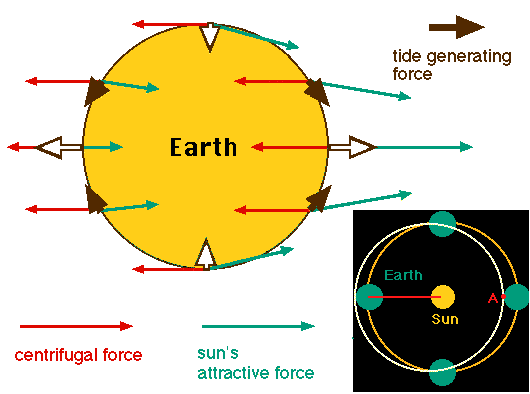

The figure on the right shows the earth's movement as revolution without rotation. The golden circle shows the path of the earth's centre in space, the white circle the path of point A. Note that the orientation of the earth's axis in space does not change and that as a consequence the diameter of both circles is the same. This means that the centrifugal force experienced by all points on the earth (as well as inside it) is the same, in magnitude and direction.
The gravitational force exerted by the sun always points to the centre of the sun. The effect of this force experienced by points on the earth's surface therefore varies with position, in magnitude and direction. The resulting balance of forces is shown in the left diagram. The open arrows indicate a net force in the vertical direction, the full arrows indicate a net force that contains also a horizontal component. This horizontal component of the resulting force is the tide generating force.
The same principle applies to the interaction between the earth and its moon. Both bodies revolve around their common centre of gravity, which in this case is inside the earth (but not at its centre). The earth again revolves around this centre without rotation, so that the centrifugal force is the same everywhere but the gravitational force exerted by the moon varies over the earth's surface.
Note again that in addition to revolving around the sun without rotation, the earth spins around its axis. This rotation around its own axis is an entirely different issue and does not invalidate the findings about the balance between gravitational and centrifugal force with respect to the earth's revolution around the sun. Its only effect on the tides is that it moves the entire tide-generating force field (shown above) around the earth once every day.
contact address: